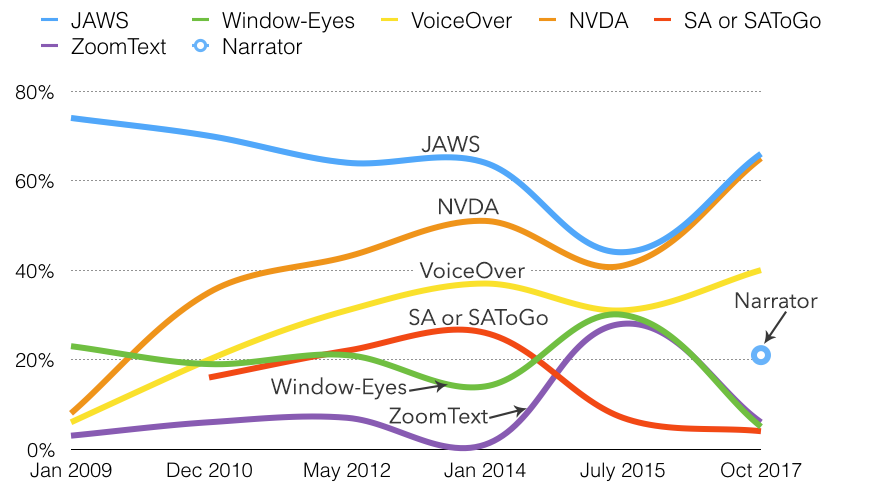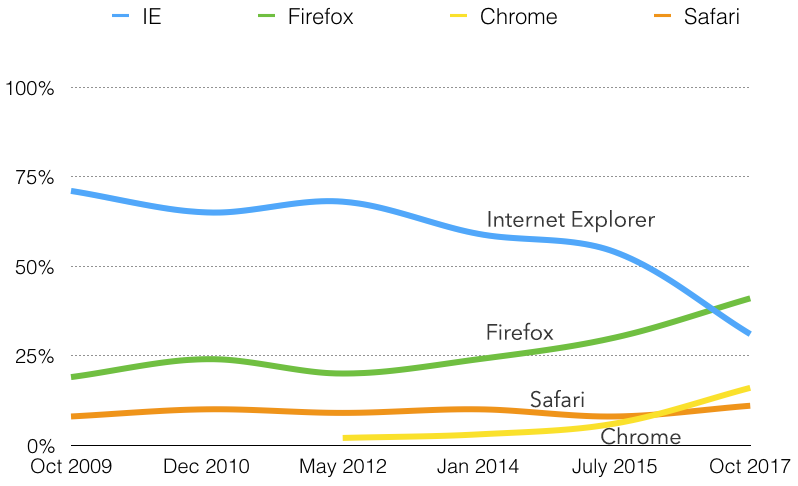The full results from our most recent Screen Reader User Survey are available at https://webaim.org/projects/screenreadersurvey7/.
There were 1792 valid responses to the survey, which was conducted October 2017.
Here are a few notable items and changes from previous surveys (the most recent having been conducted in July 2015):
- This survey had more representation world-wide then previous surveys.
- 10.9% of respondents reported not having a disability. Collecting information from these users (presumably testers or other accessibility advocates) allows us to better identify differences in usage and opinion from screen reader users that have disabilities. In general, there are typically few differences, though some notable differences are identified in the survey results.
- JAWS continued to be the most common primary screen reader at 46.6%. NVDA (31.9%) and VoiceOver (11.7%) were also common primary screen readers. Other screen readers are rarely used.
- ZoomText and Window-Eyes saw significant decreases in reported usage from 2015. This is likely due to actual decreased use (Window-Eyes has been discontinued), but may also be due to a narrower distribution of the survey and fewer respondents with low vision.
- When considering all screen readers used, JAWS was at 66% with NVDA just slightly lower at 64.9%.

- Narrator, which has seen significant recent improvements, was used as a primary screen reader by only .3% of respondents. However, 21.4% indicate that they “commonly use it”.
- Firefox (41%) surpassed Internet Explorer (31.4%) as the most common browser. However, recent versions of Firefox have significant screen reader compatibility issues, so this may change. It is of note that IE usage is still significantly higher than the overall population. Chrome usage (15.5% – a tripling of usage since 2015) also outpaced Safari usage (10.5%), with Edge usage being only .5%.

- 17.4% of survey responses were submitted via a mobile device.
- Mobile screen reader usage was at a high of 88%, with iOS devices continuing to dominate.
- 46% of respondents indicated that when performing common online tasks, such as banking or shopping, they are most likely to use a mobile app. This may reflect on the pervasiveness of mobile, or perhaps that web sites tend to be lacking in accessibility.
- 41.4% of respondents always, often, or sometimes used a keyboard when using a mobile device. This emphasized the importance of keyboard accessibility for mobile apps and web content.
- The frequent use of landmarks and regions has continually decreased from 43.8% in January 2014, to 38.6% in July 2015, to 30.5% on this survey. This decrease is rather troubling, especially consider the emphasis that accessibility advocates place on these elements. This is likely due to lack of and misuse/overuse of landmarks/regions in web content, or perhaps that navigation by headings and other elements is sufficient. Only 3.9% of respondents reported using landmarks/regions as the primary method for finding information on a lengthy web page.
- CAPTCHA remains by far the most problematic item reported by respondents. “Screens or parts of screens that change unexpectedly” has seen a significant increase over the years and is now reported as the 2nd most problematic item. This likely is due to the dynamic and complex nature of modern web pages and application.
You can review the full survey results at https://webaim.org/projects/screenreadersurvey7/. As always, we’re very open to feedback and ideas for future surveys.

Landmarks do not give you a structured way to find different sections of a website, and are almost always redundant. Forinstance, when looking between different sections, even of this site, you need headings to find where they start, not landmarks. Search regions can be found just as easily by looking for an edit control. Aria is something invented and championed by sighted people, not blind people. The main use it has is in making a screen reader behave differently, particularly in app regions. This can sometimes be useful, but often actually causes more problems than it solves, as we can’t easily escape from that part of the site to another without extra commands, and even those sometimes get broken. Headings are the most useful for us blind people, and this is something we are fairly close to having standardised, so let’s build on it. People have a good idea how to use headings now. Landmarks are not such, and to treat content as one area shows this, it’s the content we usually want to navigate around
A reluctant JAWS user after years of W-E, but I am slowly learning. Recent online re-download of update with JAWS technician plus a trip out here to the country by my computer tech yielded positive result after speech stopped. many thanks.
Survey results of help to me. Thanks again.
Zoomtext isn’t a screen reader; so those users likely don’t consider themselves screen reader users – which likely is part of the reason you don’t see it in the results consistently. The #s on the survey remain low at best and likely can’t be considered more than anecdotal when it comes to tool usage because of it.
Jeffrey –
ZoomText certainly is a screen reader. It may primarily be used for magnification, but it definitely has screen reader functionality.
We’d love to conduct a truly representative survey of screen reader users, but barring very significant funding to make that happen, we certainly hope these data are helpful and insightful. If not fully representative of all screen reader users, we can at least know that they are representative of the 1792 people that took the time to respond.
“Screens or parts of screens that change unexpectedly” – are we talking sliders (carousels) here?